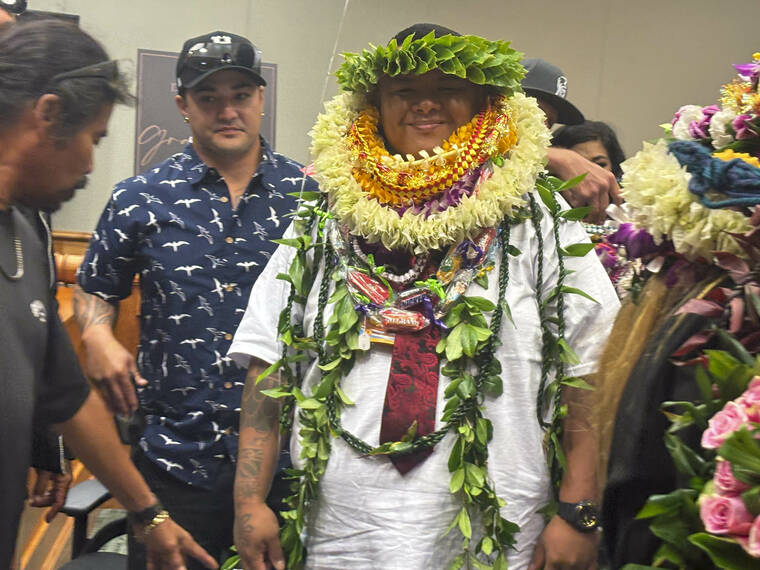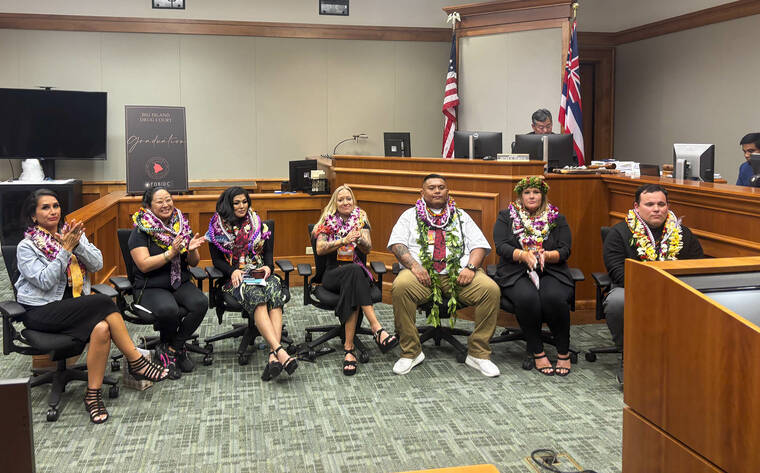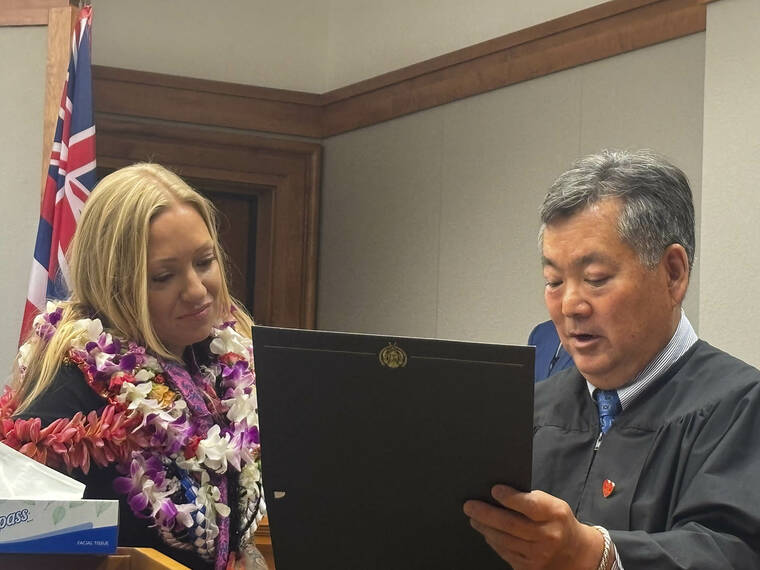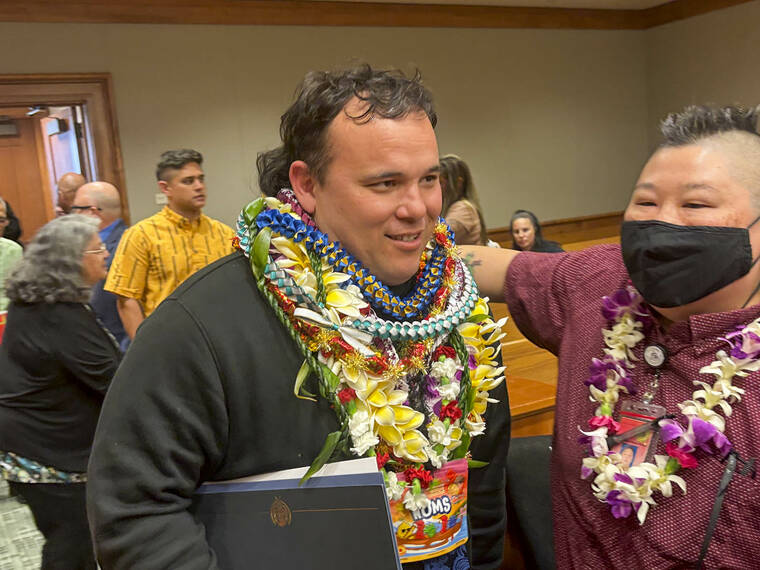‘I finally have my self back’: Graduates celebrate completion of Big Island Drug Court





Seven people celebrated returning to themselves at the 73rd Big Island Drug Court commencement ceremony at Hilo’s Third Circuit court on May 15. Judge Peter Kubota said it was the biggest group of program graduates he’d presided over since becoming a Drug Court judge in 2022.
“In Drug Court, we build their foundation,” Kubota said, explaining the four pillars of getting sober, maintain a home, gaining education and attaining a job. “Drug use, mental issues, and exposure to trauma: If you have one of them, the odds are 80% that you’ll have the other two. That’s why Drug Court deals with the individual because everybody has a different story to tell.”
ADVERTISING
Big Island Drug Court has been offered to people navigating the legal system in Kona and Hilo since 2002. Drug Court coordinator Grayson Hashida said there are currently 61 Drug Court participants in Hilo and 49 in Kona.
Individuals with a high risk of recidivism and little to no violence in their criminal offenses are likely candidates for BIDC, where the recent graduates all described a similar path: serving a small amount of jail time before completing rehab, then successfully advancing from an assisted sober-living facility to living independently, earning at least a high school level of education, attaining a driver’s license, and holding down employment — all while remaining sober.
The day before graduation, the seven participants showed the camaraderie that had grown between them, finishing each other’s sentences as they jointly lamented the necessity of avoiding concerts (one of several “off-limit zones”) and cheered on each other’s successes.
That familial bond is entrenched throughout the Drug Court network, from graduates to new entrants, from recovery doctors to parole officers, and from attorneys of both sides to the judge, the essential parental figure of the group.
“I finally have my self back, because I lost it for a while,” said Amy Lou Smith, 43, of Hilo, who went from being addicted to heroin, meth and cocaine to being a three-years-sober, bright-eyed source of joy for her coworkers at the Waiakea Water company, several of whom attended the commencement ceremony.
“I got a job, a truck, my family, everything in life I took for granted when I was in addiction,” said 34-year-old Ronald Alta Jr., who is 2 1/2 years sober from meth and heroin. He goes by “Bronson” to those who love him, including the “braddahs” he thanked in his commencement speech who were there hugging him tightly after the graduation, stacking lei up to his chin.
“It was really difficult for me at first, but it really changed my life,” said Hilo native Tiarre Kobayashi, 26, who went from needing a second, third and fourth chance to make her Drug Court appointments when she was addicted to pills, meth, heroin and cocaine, to now having two jobs as she enters her third year of sobriety, both as a manager at the downtown Subway and working alongside her sister, Bree, at the family’s Keaukaha General Store.
“I think the one thing that Drug Court taught me is that my past doesn’t define me. I made mistakes, I can’t change my past, but I can learn from it and choose not to repeat the same mistakes,” said Stefani Sugimoto, 41, who followed a path many have discovered through Drug Court: going to work at the treatment facility where she received rehabilitation for her 8-year-long meth addiction, Big Island Substance Abuse Council.
Now two years sober, Sugimoto went on to say that regaining her relationship with her family, especially her children, was “one of the biggest blessings” the experience brought her. Her daughter spoke at the commencement, thanking her mother for coming back and assuring her that “the love never went away, it’s unconditional.”
Sampson Davidson, 40, of Mountain View also had his wife and children ranging from toddlers to teens present at the commencement, representing all he’d regained through Drug Court.
Davidson was continuously on probation for 15 years and “did whatever I could find,” including heroin, fentanyl, oxycodone, crack, meth, marijuana and alcohol before entering the program four years ago. He now says that, “in my personal life, nothing changes after I graduate. I’ve conformed to the lifestyle I have now.”
“I’m grateful for the breath of life,” said Kona native Suliana Tui, 39, who works as a dental assistant as she celebrates two years and 11 months sober from fentanyl. “I’m grateful for every day, because I do have some friends that did pass away within the past two years. That could’ve been me, so I’m truly grateful to Drug Court.”
Drug Court coordinator Hashida said that, while meth is still the community’s biggest substance problem alongside alcohol, “fentanyl use and its lethality is also of grave concern.”
Meth was the main issue facing 29-year-old Ku‘ulei Marques of Ka‘u before she entered the program just under four years ago. Now 14 months sober, Marques said she nearly maxed out her time allowed in Drug Court because she kept postponing her GED out of a lack of belief in herself.
“I did it on my first try after putting it off for so long,” she said, saying the accountability to all the people keeping her on track through Drug Court is what allowed her to regain access to her children, a car and an apartment. “On regular probation, they let you go if you’re doing good … (but now I have) my family around me, supporting me, and getting to spend holidays with them.”
Drug Court is part of a nationwide system of compassionate judicial correction programs that focus on a specific needs like substance abuse, mental health or gender-related issues like victimized women. The programs have been helping people avoid incarceration and improve their lives for three decades, according to the National Association of Drug Court Professionals (also known as All Rise).
The nonprofit Friends of Big Island Drug Court states that 500 people have entered the program, with 341 successfully graduating, and 90% of the graduates were not charged with a felony three years after the program. However, Hashida clarified that those statistics seem to be from before 2019, when the best practices model to calculate the recidivism rate changed by looking at everyone who entered the program at all, not just the graduates.
Hashida’s present calculations based on this new best practices model — which include individuals who may have not attended a single day of the rehabilitation process — show a still-impressive 76% success rate, with 24% of participants charged with a felony in the three years after entering the program. This is still significantly less than the 50% to 55% recidivism national average for people not utilizing such programs, according to the United States Sentencing Commission.
Email Kyveli Diener at kdiener@hawaiitribune-herald.com.









